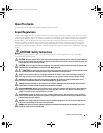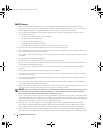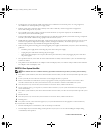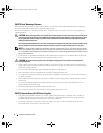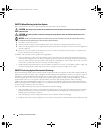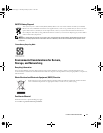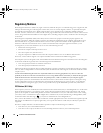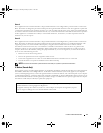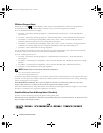
8 Product Information Guide
SAFETY: Rack Mounting of Systems
Observe the following precautions for rack stability and safety. Also refer to the rack installation documentation accompanying
the system and the rack for specific caution statements and procedures.
Systems are considered to be components in a rack. Thus, "component" refers to any system as well as to various peripherals or
supporting hardware.
CAUTION: Before installing systems in a rack, install front and side stabilizers on stand-alone racks or the front stabilizer on
racks joined to other racks. Failure to install stabilizers accordingly before installing systems in a rack could cause the rack to
tip over, potentially resulting in bodily injury under certain circumstances. Therefore, always install the stabilizer(s) before
installing components in the rack.
After installing system/components in a rack, never pull more than one component out of the rack on its slide assemblies at one
time. The weight of more than one extended component could cause the rack to tip over and may result in serious injury.
NOTE: Your system is safety-certified as a free-standing unit and as a component for use in a rack cabinet using the customer
rack kit. The installation of your system and rack kit in any other rack cabinet has not been approved by any safety agencies. It is
your responsibility to ensure that the final combination of system and rack complies with all applicable safety standards and local
electric code requirements.
• System rack kits are intended to be installed in a rack by trained service technicians. If you install the kit in any other rack,
be sure that the rack meets the specifications of a computer manufacturer rack.
CAUTION: Do not move racks by yourself. Due to the height and weight of the rack, a minimum of two people should
accomplish this task.
• Before working on the rack, make sure that the stabilizers are secured to the rack, extended to the floor, and that the full
weight of the rack rests on the floor. Install front and side stabilizers on a single rack or front stabilizers for joined multiple
racks before working on the rack.
• Always load the rack from the bottom up, and load the heaviest item in the rack first.
• Make sure that the rack is level and stable before extending a component from the rack.
• Use caution when pressing the component rail release latches and sliding a component into or out of a rack; the slide rails
can pinch your fingers.
• After a component is inserted into the rack, carefully extend the rail into a locking position, and then slide the component
into the rack.
• Do not overload the AC supply branch circuit that provides power to the rack. The total rack load should not exceed
80 percent of the branch circuit rating.
• Ensure that proper airflow is provided to components in the rack.
• Do not step on or stand on any component when servicing other components in a rack.
SAFETY: Systems Using -48-VDC Power Supplies
• This product is intended for restricted access locations (dedicated equipment rooms, equipment closet, or the like) in
accordance with Articles 110-5, 110-6, 110-11, 110-14, and 110-17 of the National Electrical Code, American National
Standards Institute (ANSI)/National Fire Protection Association (NFPA) 70.
• Connect the equipment to a 48-V direct current (DC) supply source that is electrically isolated from the AC source.
The 48-VDC source is to be reliably connected to earth.
book.book Page 8 Tuesday, January 9, 2007 11:43 AM








